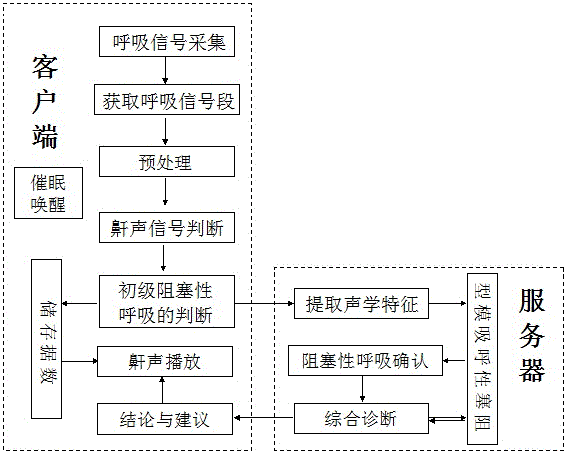Method for monitoring sleep respiration based on snore signals
A sleep breathing and signal technology, applied in the evaluation of respiratory organs, diagnostic recording/measurement, medical science, etc., can solve the problems of affecting patients' sleep quality and high cost, and achieve the effect of easy promotion, cost control, and quality assurance
- Summary
- Abstract
- Description
- Claims
- Application Information
AI Technical Summary
Problems solved by technology
Method used
Image
Examples
Embodiment Construction
[0027] The specific implementation manners of the present invention will be further described in detail below in conjunction with the accompanying drawings.
[0028] Such as figure 1 As shown, a sleep breathing monitoring method based on a snoring signal designed by the present invention is implemented in practical applications, specifically referring to the following steps:
[0029] Step 001. Since the vocal frequency of a person is 300-3400Hz, the client (smartphone) is used to continuously record and obtain the continuous breathing signal of a single sleeping person to be tested in real time according to the preset sampling frequency of 8000Hz. At the same time, in order to save data storage space, Also in order to save the data traffic uploaded by the user to the server, quantify the data to 8bit, and enter step 002.
[0030] For the operation in the above step 001, there are two situations in practical application, one is to process multiple sleepers to be tested at the ...
PUM
 Login to View More
Login to View More Abstract
Description
Claims
Application Information
 Login to View More
Login to View More - R&D
- Intellectual Property
- Life Sciences
- Materials
- Tech Scout
- Unparalleled Data Quality
- Higher Quality Content
- 60% Fewer Hallucinations
Browse by: Latest US Patents, China's latest patents, Technical Efficacy Thesaurus, Application Domain, Technology Topic, Popular Technical Reports.
© 2025 PatSnap. All rights reserved.Legal|Privacy policy|Modern Slavery Act Transparency Statement|Sitemap|About US| Contact US: help@patsnap.com

